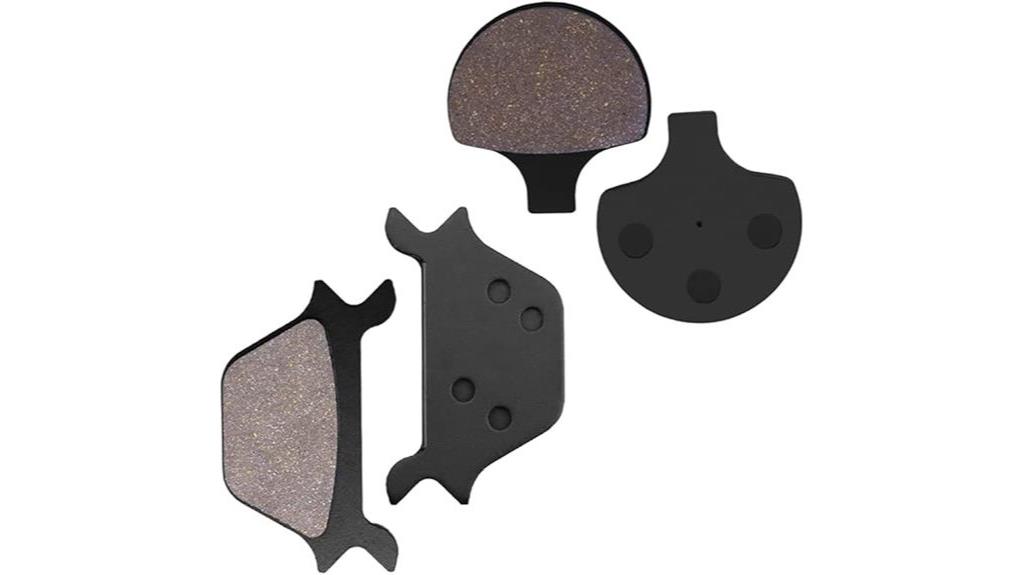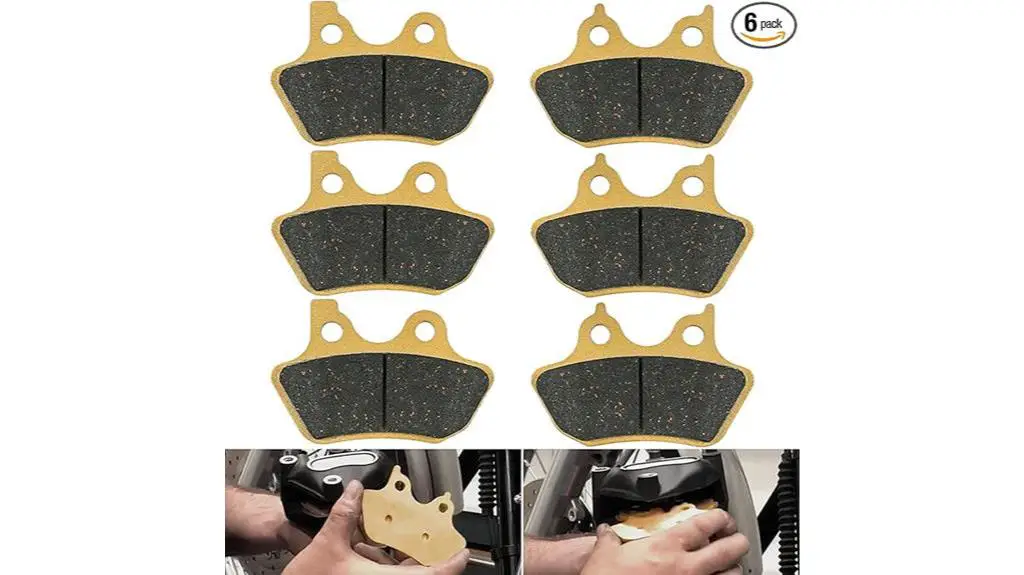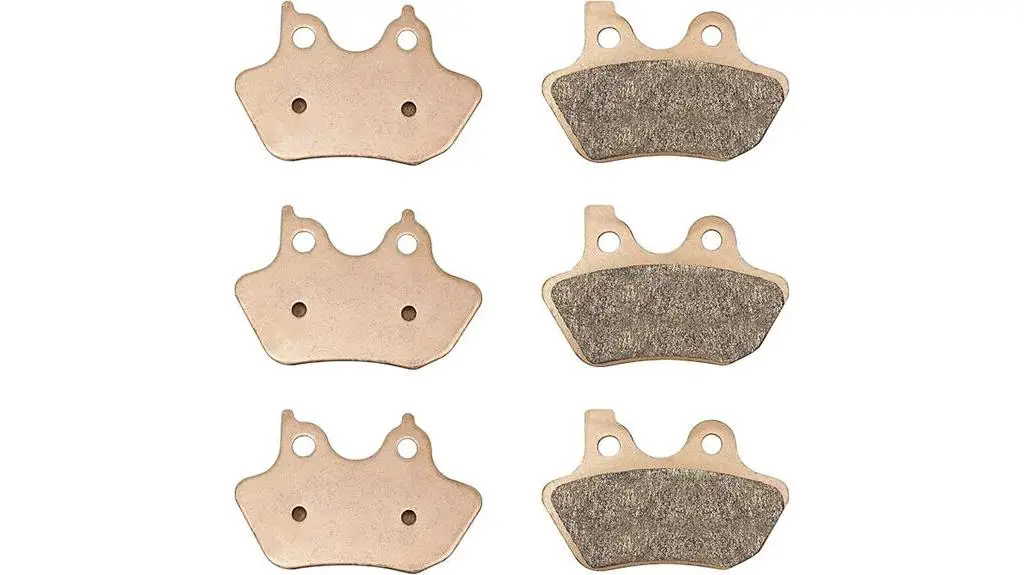Did you know that the right brake pads can markedly influence not just your stopping power but also your motorcycle's overall handling? Many riders overlook this vital aspect, which can affect safety and performance on the road. By exploring the three best options—semi-metallic, ceramic, and sintered pads—you can discover how each type can enhance your Harley Davidson experience. Understanding the unique benefits of these pads will help you make an informed choice that could transform your ride. So, what should you consider when selecting the perfect brake pads for your bike?
Quick Takeaways
- Semi-metallic brake pads provide high-temperature resistance and stable friction, enhancing braking power for models like Fatboy and Sportster from 1988-1999.
- Ceramic brake pads offer increased stopping power and quieter operation, specifically designed for Harley Davidson Touring models from 2000-2007.
- Sintered brake pads feature a copper plating base, ensuring effective braking and quiet operation, compatible with various models including Dyna and Electra Glide.
- User-friendly installation allows for quick setup with simple tools, enhancing ride safety and performance by ensuring proper fitment.
- Environmental impact awareness is promoted through low-wear formulas and eco-friendly materials, contributing to cleaner air and less waste from frequent replacements.
Brake Pads for Harley-Davidson Motorcycles (1988-1999)

For Harley-Davidson enthusiasts riding models from 1988 to 1999, the LOCOPOW brake pads are an excellent choice. These semi-metal, non-asbestos pads, designed specifically for models like the Fatboy and Sportster, deliver high-temperature resistance and stable friction performance. Their soft friction material boasts a low wear rate, ensuring a long service life while effectively resisting heat and water decay. The unique design, featuring grooves and chamfered surfaces, minimizes noise and enhances comfort during rides. Weighing just 1.46 pounds, they're easy to install and maintain. With an impressive customer rating of 4.5 stars, LOCOPOW brake pads stand out in the automotive market, promising a safer, more enjoyable riding experience overall.
Best For: Harley-Davidson motorcycle owners from 1988 to 1999 seeking reliable and durable brake pads for enhanced safety and performance.
Pros:
- High temperature resistance and stable friction performance for improved braking power.
- Long service life with low wear rate, reducing the need for frequent replacements.
- Unique design features minimize noise and enhance comfort during rides.
Cons:
- Some users report issues that may lead to rotor damage.
- Customer experiences vary, with mixed feedback on fit and performance.
- Limited warranty information available upon request.
Heavy-duty Ceramic Brake Pads for Harley Davidson Touring 2000-2007

Riders seeking enhanced braking performance for their Harley Davidson Touring models from 2000 to 2007 will find the Heavy-duty Ceramic Brake Pads to be an excellent choice. Manufactured by Yoursme, this set includes two front pads and one rear pad, designed specifically for compatibility with various Harley models. These ceramic pads provide increased stopping power and sensitivity, ensuring a quieter and more efficient ride. Their construction features copper fibers, enhancing thermal stability and durability, while non-ferrous metal filaments help reduce brake fade and rotor wear. Installation is straightforward, needing just basic tools. With a 12-month warranty and a customer satisfaction guarantee, these brake pads prove to be a reliable upgrade for any touring enthusiast.
Best For: Riders of Harley Davidson Touring models from 2000 to 2007 looking to upgrade their braking performance and enhance riding safety.
Pros:
- Enhanced brake sensitivity and increased stopping power for improved safety.
- Quieter operation compared to standard brake pads, providing a smoother ride.
- Easy installation with basic tools, making it accessible for DIY enthusiasts.
Cons:
- Compatibility limited to specific Harley Davidson models, not suitable for all bikes.
- Weighing 1.76 pounds may be heavier than some riders prefer.
- Performance may vary depending on riding conditions and styles.
Sintered Front Rear Brake Pads for Harley Davidson Motorcycles

Offering exceptional performance in varying conditions, the Sintered Front Rear Brake Pads are designed specifically for Harley Davidson motorcycles, making them an ideal choice for enthusiasts who demand reliability and durability. These pads feature a copper plating base and a specialized sintered formula that guarantees effective braking even in adverse weather. Compatible with various models, including the Dyna, Electra Glide, and Street Glide from 2000 to 2007, they provide a seamless fit. Customers appreciate their quiet operation and quick shipping, reflected in an impressive average rating of 4.7 out of 5 stars. With a 1-year warranty and 24-hour customer support from JAVIK, riders can trust these brake pads to enhance their safety and performance on the road.
Best For: Enthusiasts of Harley Davidson motorcycles looking for reliable and durable brake pads suitable for various models from 2000 to 2007.
Pros:
- High performance in diverse weather conditions, ensuring effective braking.
- Quiet operation reported by customers, enhancing riding comfort.
- Backed by a 1-year warranty and 24-hour customer support for peace of mind.
Cons:
- Limited compatibility, only fitting specific Harley Davidson models from 2000 to 2007.
- Average customer rating may not reflect all individual preferences and experiences.
- Made in China, which may be a concern for some buyers preferring local products.
Factors to Consider When Choosing Brake Pads for Harley Davidsons
When choosing brake pads for your Harley Davidson, you need to take into account several key factors. The material type, compatibility with your specific model, and performance features all play essential roles in ensuring safety and longevity. Additionally, think about noise reduction capabilities to enhance your riding experience.
Material Type Selection
Choosing the right brake pad material for your Harley Davidson involves considering several key factors that can greatly affect your riding experience. Brake pads are typically made from semi-metallic, ceramic, and sintered compounds, each with distinct performance characteristics suited for different riding conditions.
Semi-metallic brake pads, often containing brass, excel in high temperature resistance and offer stable friction performance. However, they may produce more dust, which can be a concern for some riders. On the other hand, ceramic brake pads are known for their quieter operation, enhanced sensitivity, and longevity. They perform effectively in both dry and wet conditions while minimizing rotor wear, making them a solid choice for everyday riding.
If you frequently ride in harsh environments, sintered brake pads could be your best bet. Made from metal compounds, they provide excellent durability, superior stopping power, and efficient heat conduction. Ultimately, the material you choose will greatly impact braking efficiency, noise levels, and the overall lifespan of both the pads and rotors. Taking the time to select the right type will enhance your bike's performance and guarantee a safer ride.
Compatibility With Models
Compatibility is vital when selecting brake pads for your Harley Davidson, as each model has specific requirements that can affect performance and safety. Different Harley models have unique brake pad designs, meaning what fits one bike may not fit another. For instance, brake pads designed for motorcycles built between 1988-1999 won't fit models made from 2000 onwards due to design changes.
To guarantee the right fit, always check the manufacturer's part numbers, including OEM numbers. This will confirm that the brake pads you choose are compatible with your specific model. Many brake pads also indicate their compatibility range, such as those suitable for Dyna models from 2000-2007 or Touring models from 2000-2007. This information can be incredibly helpful in making an informed decision.
Additionally, consulting your vehicle's manual or manufacturer specifications is vital. This guarantees that the selected brake pads align seamlessly with your Harley Davidson's brake system. By paying attention to compatibility, you'll enhance both the safety and performance of your ride, allowing you to enjoy the open road with confidence.
Performance Features Importance
Performance features play an essential role in the effectiveness of brake pads for your Harley Davidson. When choosing brake pads, consider high temperature resistance and stable friction performance, especially if you ride in varied conditions. These traits guarantee your brakes work effectively, allowing for safe stops.
Look for brake pads with low-wear formulas. They not only reduce dust emissions, contributing to a cleaner environment but also extend the lifespan of the pads. Enhanced brake sensitivity and responsiveness are important, too, as they increase your stopping power. This is crucial for your safety and control during emergencies.
Additionally, consider how the brake pads perform in wet or harsh conditions. Reliable performance minimizes the risk of brake fade, ensuring you can stop quickly when it matters most. Also, quieter operation can enhance your riding experience; it indicates effective friction material design and helps reduce noise during braking.
Longevity and Durability
When it comes to brake pads for your Harley Davidson, longevity and durability are key factors that shouldn't be overlooked. You want pads that can withstand the demands of your rides while providing consistent performance. Semi-metallic brake pads often shine in this area, as they offer high temperature resistance and stable friction performance, contributing to their long life.
On the other hand, ceramic brake pads are also a great option, known for their effectiveness in both dry and wet conditions, which minimizes wear over time. Choosing pads with a low-wear formula can help reduce dust emissions, extending their lifespan and enhancing your bike's performance while being environmentally conscious.
Additionally, look for brake pads designed with grooves and chamfered surfaces. These features improve adhesion and comfort, leading to less stress on the material and a longer service life. Finally, consider sintered brake pads made from copper and tin compounds; they're engineered for durability in harsh conditions, making them ideal for extended use. By carefully selecting the right materials and designs, you can guarantee your brake pads will stand the test of time on your Harley.
Noise Reduction Capabilities
Choosing the right brake pads for your Harley Davidson involves more than just considering durability; noise reduction capabilities play an essential role in enhancing your overall riding experience. You want to enjoy your ride without the distraction of annoying squeaks and rattles. Brake pads designed with grooves and chamfered surfaces can greatly reduce noise during operation, adding to your comfort on the road.
Opting for soft friction materials in your brake pads can also contribute to an extremely low wear rate, minimizing the noise generated during braking. Sintered brake pads tend to operate quieter compared to other types due to their construction, ensuring better adhesion and stability under various conditions.
Moreover, investing in high-quality brake pads with a low-wear formula not only curbs dust emissions but also limits noise, promoting a cleaner and quieter ride. Finally, selecting pads with improved thermal stability can further reduce noise, as they maintain consistent performance even in high-temperature situations. By focusing on these features, you can enhance your ride's safety, performance, and overall enjoyment.
Installation Process Ease
Installing brake pads on your Harley Davidson can be a quick and straightforward task, especially with many products designed for user-friendly installation. Most brake pads come with clear instructions and require no special tools, allowing you to complete the job in just a few minutes using simple hand tools. This makes it accessible even if you don't have extensive mechanical knowledge.
When you purchase a brake pad set, you'll typically find both front and rear pads included, enabling you to replace all necessary components at once for peak performance. Some brands emphasize user-friendly design features, such as pre-marked alignment points or simplified fitting guides, which can greatly enhance your installation experience.
However, it's essential to follow the manufacturer's installation guidelines to guarantee proper fitment and functionality. Doing so will help you avoid potential issues like noise or reduced braking efficiency later on. With the right brake pads, you'll not only enjoy the ease of installation but also the peace of mind that comes with knowing you've done the job right. So get ready to enhance your ride's safety and performance with confidence!
Environmental Impact Awareness
As a Harley Davidson owner, you might not realize how your choice of brake pads can impact the environment. Selecting brake pads made from low-wear formulas can greatly reduce dust emissions, helping to keep the air cleaner and less polluted. By opting for non-asbestos materials, you minimize harmful chemical exposure during use, which promotes better air quality for everyone.
Durable, high-quality brake pads also lead to less frequent replacements, which means you contribute to reduced waste and resource consumption over time. If you're concerned about the environment, consider eco-friendly options that often use materials like ceramic or semi-metal. These alternatives can deliver similar performance while being less harmful to the planet.
Additionally, choosing brake pads that excel in both dry and wet conditions not only enhances your vehicle's safety but can also reduce the likelihood of accidents. Fewer accidents mean less environmental impact from collisions, benefiting both you and the community. By being mindful of these factors when selecting brake pads, you can enhance your ride's performance while also making a positive contribution to the environment.
Warranty and Support Options
When investing in brake pads for your Harley Davidson, warranty and support options play a essential role in ensuring peace of mind. Many brake pads come with a warranty period that can range from 12 months to a lifetime, depending on the manufacturer and product specifications. Before making a purchase, it's important to check the warranty details to understand the coverage and claims process.
Additionally, consider the customer service availability of the brand. Some manufacturers offer accessible support and satisfaction guarantees, which can greatly enhance your buying experience. Knowing that you can reach out for help if needed can make all the difference.
Retailers often provide a 30-Day Return Guarantee, allowing you to return products if you're unsatisfied or if the item doesn't fit properly. This option adds another layer of security to your purchase.
Common Questions
How Often Should I Replace My Harley Davidson Brake Pads?
You should check your Harley's brake pads regularly, ideally every 5,000 to 10,000 miles, depending on your riding style and conditions. If you notice squeaking, grinding, or reduced braking performance, it's time to replace them. Also, inspect the pads visually; if they're worn down to about 1/8 inch, don't wait—swap them out. Keeping your brake pads in good condition guarantees your safety and enhances your riding experience.
Can I Mix Different Types of Brake Pads on My Harley?
You shouldn't mix different types of brake pads on your Harley. Each type is designed with specific materials and performance characteristics, which can lead to uneven wear and compromised braking efficiency. Mixing might also affect your bike's handling and stability, putting you at risk. It's best to stick with a matched set for peak performance. If you're unsure, consult your owner's manual or a professional for guidance on the right brake pads for your ride.
Do Brake Pads Affect My Motorcycle's Warranty?
Yes, brake pads can affect your motorcycle's warranty. If you use aftermarket pads that don't meet the manufacturer's specifications, it might lead to warranty issues. Most warranties cover defects and workmanship, but if modifications cause damage, the manufacturer might deny your claim. To keep your warranty intact, always check your owner's manual and consider using pads recommended by the manufacturer. It's better to be safe than sorry when it comes to warranty claims.
What Symptoms Indicate I Need New Brake Pads?
You'll notice a few symptoms when it's time for new brake pads. If you hear squeaking or grinding noises when you brake, that's a clear sign. You might also feel a vibration or reduced stopping power, indicating wear. If your brake warning light comes on, don't ignore it. Additionally, check for uneven wear on the pads or if the pedal feels spongy. Addressing these issues early can keep your ride safe and smooth.
Are There Any Environmental Considerations for Brake Pad Disposal?
When it comes to brake pad disposal, you've got to contemplate the environmental impact. Many brake pads contain harmful materials like asbestos or heavy metals that can pollute soil and water if not disposed of properly. Instead of tossing them in the trash, look for local recycling programs or hazardous waste facilities that can handle them. By taking these steps, you're helping protect the environment and ensuring safer disposal practices.
Wrapping Up
When it comes to your Harley, choosing the right brake pads can make all the difference in safety and performance. Did you know that upgrading to high-quality brake pads can reduce stopping distances by up to 20%? By opting for semi-metallic, ceramic, or sintered pads, you're not only enhancing your ride's safety but also ensuring a smoother, more enjoyable experience on the road. Invest in your ride today, and feel the difference in every stop!




Leave a Reply
You must be logged in to post a comment.